Family name: Apiaceae Lindley
Synonym(s): Actinotaceae A. I. Konstant. & Melikyan; Ammiaceae Bercht. & J. Presl; Angelicaceae Martinov; Daucaceae Martinov; Ferulaceae Sacc.; Saniculaceae Bercht. & J. Presl; Umbelliferae Juss., nom. cons.
Common name(s): carrot family
*Number of genera/species: 442/3,575
List of genera records in GRIN-Global
Fruit a schizocarpschizocarp:
usually dry fruit splitting between two or more locules to form distinct, indehiscent, usually one seeded segments; fruit derived from a single, superior or inferior, compound ovary; compare to mericarp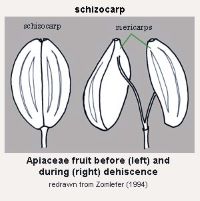 splitting into 2 dry segments (mericarpsmericarp:
splitting into 2 dry segments (mericarpsmericarp:
a one-seeded section (carpel) of a schizocarp, as in Apiaceae fruits (compare schizocarp)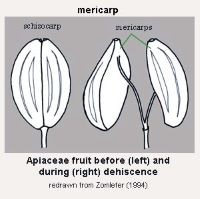 ) at maturity. MericarpsMericarp:
) at maturity. MericarpsMericarp:
a one-seeded section (carpel) of a schizocarp, as in Apiaceae fruits (compare schizocarp) usually attached to a deeply forked central stalk (carpophorecarpophore:
usually attached to a deeply forked central stalk (carpophorecarpophore:
the stalk supporting a mericarp after dehiscence of a schizocarpic fruit, the central axis of the fruit having split longitudinally to yield two or four such stalks; composed of receptacular and (primarily) gynoecial tissues, esp. in Apiaceae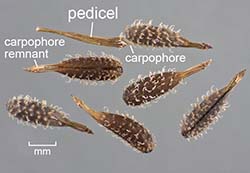 ), 0.7–25 mm long (if calyxcalyx:
), 0.7–25 mm long (if calyxcalyx:
the outer whorl of the perianth; all the sepals of a flower teeth persistent to 50 mm long), globoseglobose:
teeth persistent to 50 mm long), globoseglobose:
3D shape—more or less spherical to quadrangularquadrangular:
to quadrangularquadrangular:
2D shape—four-sided, as in a square or rectangle , tereteterete:
, tereteterete:
approximately circular in cross section; width and thickness approximately equal
 to flat in transection, often beakedbeak:
to flat in transection, often beakedbeak:
a usually firm, terminal appendage, sometimes tapered (stylopodiumstylopodium:
(stylopodiumstylopodium:
a discoid enlargement at the base of the styles, esp. in Apiaceae
), one seed per mericarpmericarp:
a one-seeded section (carpel) of a schizocarp, as in Apiaceae fruits (compare schizocarp) , often crowned with calyxcalyx:
, often crowned with calyxcalyx:
the outer whorl of the perianth; all the sepals of a flower teeth. Fruit usually with apparent globular to linearlinear:
teeth. Fruit usually with apparent globular to linearlinear:
(shape) long, narrow, and uniform in width; (of embryo) embryo is straight and much longer than wide oil canals. Pericarppericarp:
oil canals. Pericarppericarp:
fruit wall or fruit coat
brown, black, gray, green, or yellow, rarely blue or dark purple, oil glands often differently colored from pericarppericarp:
fruit wall or fruit coat
. Pericarppericarp:
fruit wall or fruit coat
shiny or dulldull:
reflecting only a low proportion of incident light, with no apparent sheen , membranousmembranous:
, membranousmembranous:
texture—extremely thin, pliable, and fairly tough
, scariousscarious:
texture—dry, thin, membranous, non-green, more or less translucent
, corkycorky:
firm, relatively light, discontinuous but strongly cohesive, and resilient
, or spongyspongy:
soft, light, discontinuous but cohesive, and somewhat resilient
, rarely fleshy, glabrousglabrous:
without hairs
or pubescentpubescent:
surface relief—bearing hairs
, smooth, ribbedribbed:
surface relief—wide, prominent, linear ridges that are generally rounded and longitudinally situated on the surface , or wartywarty:
, or wartywarty:
surface relief—distinct, rounded projections that are large relative to the fruit size; tuberculate, verrucose , and sometimes covered with scales, prickles, bristles, spines, or barbs. Fruit ribbedribbed:
, and sometimes covered with scales, prickles, bristles, spines, or barbs. Fruit ribbedribbed:
surface relief—wide, prominent, linear ridges that are generally rounded and longitudinally situated on the surface . Ribs sometimes develop into wings, which are thin, corkycorky:
. Ribs sometimes develop into wings, which are thin, corkycorky:
firm, relatively light, discontinuous but strongly cohesive, and resilient
, spongyspongy:
soft, light, discontinuous but cohesive, and somewhat resilient
or woodywoody:
texture—consisting mainly of indurate lignified tissues, characteristic of or resembling wood
.
Seeds nearly globoseglobose:
3D shape—more or less spherical to reniformreniform:
to reniformreniform:
2D or 3D shape—kidney-shaped , strongly compressedcompressed:
, strongly compressedcompressed:
flattened; in grasses, used to denote compression (not necessarily flattened) either laterally or dorsiventrally
or tereteterete:
approximately circular in cross section; width and thickness approximately equal
 in transection. Seed coat adherent to pericarppericarp:
in transection. Seed coat adherent to pericarppericarp:
fruit wall or fruit coat
. Seeds not usually encountered as seed coat is strongly adherent to fruit wall.
Embryo straight.
Endosperm copious.
Can be a weed in grasslands, wetlands, upland fields and forests and reproduces by seed and stolon propagation. Sometimes forms dense clumps, predominant populations, or monocultures. Both Daucus carota and Cyclospermum leptophyllum are considered invasive and noxious in many countries and regions around the world.
Noxious Weed: USA Federal Noxious Weed List, terrestrial, Heracleum mantegazzianum Sommier & Levier.
Federal Noxious Weed Disseminules of the US tool provides description and images of this species.
Aquarium & Pond Plants of the World tool includes descriptions and images of genera, which may be encountered.
| Fruit | |
| Type | schizocarpschizocarp: usually dry fruit splitting between two or more locules to form distinct, indehiscent, usually one seeded segments; fruit derived from a single, superior or inferior, compound ovary; compare to mericarp  |
| Size range | 0.7–25 mm long (if calyxcalyx: the outer whorl of the perianth; all the sepals of a flower  teeth persistent to 50 mm long) teeth persistent to 50 mm long) |
| Shape(s) | globoseglobose: 3D shape—more or less spherical  , orbicularorbicular: , orbicularorbicular:2D shape—circular in outline, 3D shape—globose 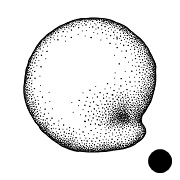 , oblongoblong: , oblongoblong:2D shape—much longer than broad with nearly parallel sides, corners are rounded  , ellipsoidellipsoid: , ellipsoidellipsoid:3D shape—elliptic , ovoidovoid: 3D shape—ovate  , didymousdidymous: , didymousdidymous:3D shape - paired, usually inflated and appears as two globose to ovoid halves pressed together , cylindricalcylindrical: 3D shape—a cylinder, with parallel sides and a circular cross-section; tubular or rod-shaped , clavateclavate: 3D shape—club-shaped, with attachment at or near narrow end (compare obclavate) 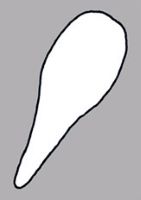 , pear-shaped, cordatecordate: , pear-shaped, cordatecordate:2D shape—heart-shaped, with attachment at or near the broad end (compare obcordate) 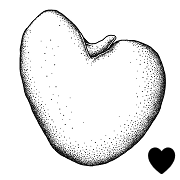 , polygonalpolygonal: , polygonalpolygonal:angular , linearlinear: (shape) long, narrow, and uniform in width; (of embryo) embryo is straight and much longer than wide  , nearly hemisphericalhemispherical: , nearly hemisphericalhemispherical:2D shape—shaped like half a sphere , reniformreniform: 2D or 3D shape—kidney-shaped  |
| Texture | membranous, scariousscarious: texture—dry, thin, membranous, non-green, more or less translucent , corkycorky: firm, relatively light, discontinuous but strongly cohesive, and resilient , spongyspongy: soft, light, discontinuous but cohesive, and somewhat resilient , rarely fleshy |
| Surface relief | with oil ducts, smooth, ribbedribbed: surface relief—wide, prominent, linear ridges that are generally rounded and longitudinally situated on the surface  , wartywarty: , wartywarty:surface relief—distinct, rounded projections that are large relative to the fruit size; tuberculate, verrucose  , wrinkledwrinkled: , wrinkledwrinkled:surface relief—shallow, irregular folds and furrows covering the surface; appearing overall though crumpled and then spread out  , scalyscaly: , scalyscaly:surface relief—covered with small, thin, fine scales or flakes that may be removable 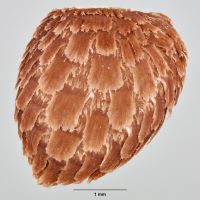 , pustulatepustular: , pustulatepustular:surface relief - with small blisters or pustules 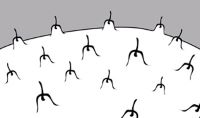 , scabrid, papillate, glochidiate, bristles, spines, prickles, barbs , scabrid, papillate, glochidiate, bristles, spines, prickles, barbs |
| Color(s) | brown (all shades), black, green, gray, yellow, rarely blue, dark purple |
| Unique features | Small, usually brown, dry mericarpsmericarp: a one-seeded section (carpel) of a schizocarp, as in Apiaceae fruits (compare schizocarp)  (often still joined together in pairs), with one side flat or concave and the other rounded with five prominent ribs or wings that alternate with the oil ducts. Fruits often crowned by a short or long stylestyle: (often still joined together in pairs), with one side flat or concave and the other rounded with five prominent ribs or wings that alternate with the oil ducts. Fruits often crowned by a short or long stylestyle:in a flower, the narrow and elongated part of the pistil between the stigma and the ovary; sometimes persisting in fruit 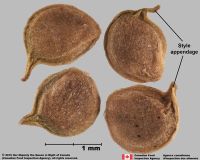 remnant with a swollen base (stylopodiumstylopodium: remnant with a swollen base (stylopodiumstylopodium:a discoid enlargement at the base of the styles, esp. in Apiaceae ). Fruits filledfilled: (of embryo) embryo fills the seed interior with the food reserves stored in the cotyledons; small amounts of endosperm may remain around the embryo 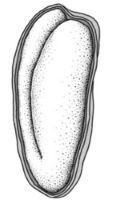 by a single seed with a straight embryo and copious endosperm. Fruits usually emit a spicy or herbal odor when crushed. by a single seed with a straight embryo and copious endosperm. Fruits usually emit a spicy or herbal odor when crushed. |
| Other | |
| Embryo | straight |
| Nutritive tissue | endosperm copious |
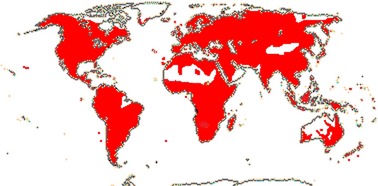
Distribution map courtesy of Angiosperm Phylogeny Website.
Flora of North America Editorial Committee 1993+Flora of North America Editorial Committee 1993+:
Flora of North America Editorial Committee, eds. 1993+. Flora of North America North of Mexico [Online]. 22+ vols. Flora of North America Association, New York and Oxford. Accessed January-March 2024. URL: http://beta.floranorthamerica.org.; Kirkbride et al. 2006Kirkbride et al. 2006:
Kirkbride JH, Jr, Gunn CR, and Dallwitz MJ. 2006. Family guide for fruits and seeds, vers. 1.0. Accessed September 2020-January 2022. URL: https://nt.ars-grin.gov/seedsfruits/keys/frsdfam/index.cfm .; Kubitzki et al. 1990+Kubitzki et al. 1990+:
Kubitzki K et al., eds. 1990+. The families and genera of vascular plants. 7+ vols. Berlin etc.; Noxious Weed Regulations 2020Noxious Weed Regulations 2020:
Noxious Weed Regulations. 2020. 7 C.F.R. sect; 360.100-360.600.; Shishkin 1973Shishkin 1973:
Shishkin BK, chief and volume editor. 1973. Umbelliflorae. In: Flora of the Union of Soviet Socialist Republics, Vol 16. Botanical Institute of the Academy of Sciences of the U.S.S.R. Moskov-Leningrad. (1950). Translated by R. Lovoott, Edited by Prof. J. Lorch, Israel Program for Scientific Translations Ltd. in agreement with The Smithsonian Institute and NSF.; Takhtajan 2009Takhtajan 2009:
Takhtajan A. 2009. Flowering plants: Second edition. Springer Nature, Switzerland. 871 pp.; USDA 1980USDA 1980:
United States Dept. of Agriculture (USDA). 1980. Major weed family identification guide. Hyattsville Md, United States ; Zhengyi et al. 2004+Zhengyi et al. 2004+:
Zhengyi W, Raven PH, and Deyuan H. 2004+. Flora of China [online]. 25 vols. Science Press, Beijing China & Missouri Botanical Garden, St. Louis USA. Accessed January–March 2024. http://flora.huh.harvard.edu/china/
*The number of genera and species is based on Christenhusz and Byng 2016Christenhusz and Byng 2016:
Christenhusz MJM and Byng JW. 2016. The number of known plant species in the world and its annual increase. Phytotaxa 261 (3): 201-217. https://doi.org/10.11646/phytotaxa.261.3.1, which may differ from the number of genera in GRIN-Global.